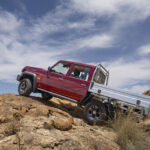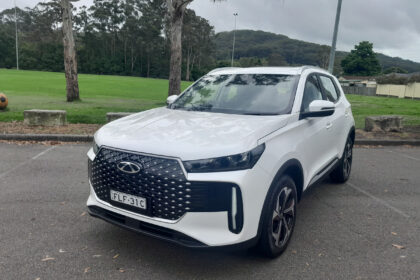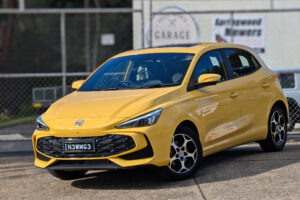
If you want a definition of the term `workhorse’ look no further than Toyota’s 70-Series
LandCruiser.
Whether it’s carrying miners or carting hay bales in every dairy farm in Australia, the
70-Series is a hard-working 4×4 – certainly not an SUV – that earns its keep day-in
day-out, year-in, year-out.
All variants are powered, and we mean powered, by a 4.5-litre V8 turbo diesel engine.
The latest, LC79, version of the 70-Series comes with four body styles: Wagon, Troop
Carrier, plus two- and five-seat Cab-Chassis.
Each comes in WorkMate or GXL grade with the Single Cab also offering a lower-spec
GX.
Our test vehicle was the GXL Single Cab cab chassis priced at $76,650 plus on-road
costs and with a genuine Toyota galvanised steel tray.
STYLING
The lads from Monty Python might have had the LandCruiser 70 Series in mind when
they said ‘And Now For Something Completely Different’.
Not in terms of what came before the current LC79, because there is very little different
here, but in comparison with everything else out there.

The closest anything comes to it is the Land Rover Defender prior to it being gentrified.
The squared-off truck-like styling of the 70-Series is instantly recognisable, having
changed little over the years.
There’s a large bonnet scoop, plenty of chrome in the grille and protruding bumper bar,
plus halogen lights and 16-inch wheels.
INTERIOR
The cabin of the LC79 is as basic as you can get. Lots of plastic all around with very
few storage spaces, which means with two occupants the passenger will need to nurse
any bags, etc.
ENGINES / TRANSMISSIONS
All LC79 variants are powered by a 4.5-litre V8 turbo-diesel that produces 151kW of
power at 3400 rpm and 430Nm of torque from 1200 to 3200 rpm.
The engine is paired with a five-speed manual transmission, with taller second and fifth
gears, the latter allowing it to cruise more easily on motorways.
Drive is to the rear wheels through a dual-range transfer case with high and low range
gearing, auto-locking front hubs plus front and rear diff locks.
The 2022 upgrade increased the LC79’s gross vehicle mass to 3510kg, not only
increasing the payload but also taking the range from the light to medium goods
category.
Braked trailer towing capacity remains at 3500kg.

SAFETY
The latest upgrade, in late-2022, added autonomous emergency braking and a Pre-
Collision Safety system including pedestrian and daytime cyclist detection, enabling it
to meet the latest ANCAP safety criteria and get the maximum five stars.
Other standard features include four airbags, ABS brakes with Brake Assist and
Electronic Brakeforce Distribution, stability and traction control and Hill-Start Assist.
However, more recent safety features are missing, including things like blind spot
monitoring, lane departure warning or correction, rear cross-traffic alert, parking
sensors and a rear-view camera – most of which are available on vehicles that are
more than half the price.
INFOTAINMENT
Like much in the LC79, the infotainment system is very basic.
Display is through a small 6.1-inch touchscreen that does have physical knobs on the
top corners to control the basic audio functions.
There is embedded satellite navigation with voice activation, Bluetooth pairing, a single
CD player and two-speaker sound – but neither Apple CarPlay nor Android Auto
connectivity.
There are two USB-A charging ports at the bottom of the dashboard alongside a 12V
socket.
There’s also a USB-C port at the bottom of the touchscreen.
DRIVING
It’s a bit of a climb to get into the LC79, helped by grab handles on either side, but once
there the cloth seats are firm but comfortable.
There’s no push button start, the key needs to be inserted in the ignition slot – don’t
mind that, at least you always know where it is.
The wing mirrors are large but not powered and need a bit of pushing and prodding to
set them properly, a real nuisance if you don’t have a passenger to help.
Once set, they contribute to excellent visibility all round with a large, almost vertical,
windscreen, large side windows and no rear seat headrests to block the view behind.
The first thing to do if you pick up a Toyota LandCruiser 70 Series in the city – as we
did – is to get out ASAP.
It’s certainly not designed for urban conditions. It’s large, heavy and cumbersome with
a large turning circle.
Steering is heavy, the brakes are spongy and there’s a fair bit of body roll.
With its 14.4 metre turning circle even moderate manoeuvres are likely to necessitate a
three-point turn.
Fortunately, Sydney’s ring of motorways let us escape and we were able to settle into
an uninterrupted trip to the Central Coast.
While it was still not in its natural habitat and it could hardly be called a cruiser, we got
a much better feel for the LC79.
There was a significant amount of engine and road noise and it really needed a sixth
gear.
On the positive side, the amount of torque, accessible across the rev range, meant the
big Cruiser moved effortlessly regardless of terrain.
The gear shift has a long throw action which makes it possible to miss third if you rush
it.
On moving off It can take three gear changes just to get across an intersection, unless
you start off in second, which is the preferred method.
Off road, with 230mm of ground clearance, 700mm wading ability, a snorkel for
breathing, low range crawler gearing, plus front and rear diff locks, the 70 Series takes
some stopping.
SUMMING UP
Whenever you travel around the great Aussie bush every second vehicle seems to be a
70-Series LandCruisers.
Some in much loved condition, others that have led a rough life – but all are still going
strong and hard, even with too little maintenance.
One reason for its popularity is that it has been developed specifically for the Australian
environment, with a tough ladder-frame chassis, live-axles, impressive ground
clearance, part-time 4×4, powerful yet efficient engine, excellent load-carrying capacity
and long touring range.
The LandCruiser 70 series gets a five-year, unlimited distance warranty that can be
extended to seven years on the powertrain when the vehicle is serviced at a Toyota
dealership.
Servicing intervals are six months or 10,000km.
Now for the bad news. About a year ago Toyota Australia instructed its dealers to stop
taking orders, and that is still the case.
Even those who had ordered their LC79 prior to that date are facing long delays.
RATINGS:
Looks: 7/10
Performance: 8/10
Safety: 6/10
Thirst: 7/10
Practicality: 5/10
Comfort: 6/10
Tech: 6/10
Value: 6/10
Overall: 6.4
MODEL RANGE
Land Cruiser 79-Series 4.5-litre diesel Workmate single cab chassis: $72,550
Land Cruiser 79-Series 4.5-litre diesel GX single cab chassis: $74,550
Land Cruiser 79-Series 4.5-litre diesel GXL single cab chassis: $76,650
Land Cruiser 79-Series 4.5-litre diesel Workmate dual cab chassis: $75,100
Land Cruiser 79-Series 4.5-litre diesel GXL single cab chassis: $79,200
Note: These prices do not include government or dealer delivery charges. Contact your
local Toyota dealer for drive-away prices.
AT A GLANCE
SPECIFICATIONS (Toyota Land Cruiser LC79 Single Cab GXL 4.5-litre V8 turbo-diesel
cab chassis.
PERFORMANCE:
Capacity: 4.461 litres
Configuration: V8
Maximum Power: 151 kW @ 3400 rpm
Maximum Torque: 430 Nm from 1200-3200 rpm
Fuel Type: Diesel
Combined Fuel Cycle (ADR 81/02): : 10.7 L/100km
CO2 Emissions: 281 g/km
DRIVELINE: Five-speed manual
DIMENSIONS, WEIGHT AND CAPACITIES:
Length: 5230 mm
Wheelbase: 3180 mm
Width: 1870 mm
Height: 1955 mm
Turning Circle: 14.4 metres
Kerb Mass: 2195 kg
Fuel Tank Capacity: 130 litres
BRAKES:
Front: Ventilated disc
Rear: Ventilated disc
STANDARD WARRANTY:
Five years, Unlimited kilometres









